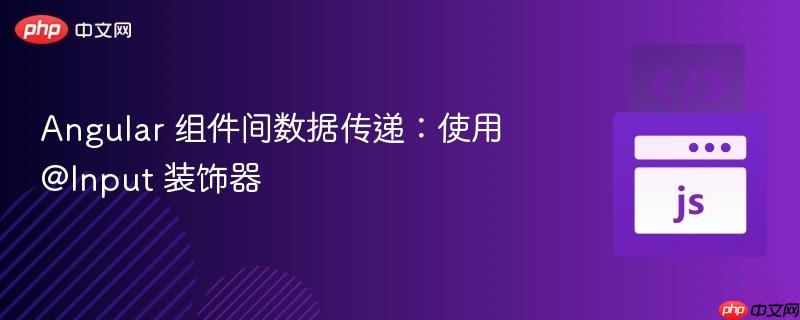
本文详细介绍了 Angular 中父组件向子组件传递数据的常用方法,重点讲解了如何使用 @Input 装饰器实现数据绑定。通过示例代码,读者可以清晰地理解如何定义输入属性,以及如何在子组件中访问和使用父组件传递的数据,并避免常见错误。
在 Angular 应用开发中,组件化是一种常见的架构模式。组件之间经常需要进行数据传递。本文将重点介绍如何使用 @Input 装饰器,将数据从父组件传递到子组件。
@Input 装饰器允许子组件接收来自父组件的数据。要使用它,需要在子组件的类中声明一个带有 @Input 装饰器的属性。
示例:
假设我们有一个 AppComponent 作为父组件,它包含一个 images 数组,我们希望将 images 数组中的每个 image 对象传递给 CardComponent 子组件。
父组件 (AppComponent):
import { Component } from '@angular/core';
@Component({
selector: 'app-root',
templateUrl: './app.component.html',
styleUrls: ['./app.component.css']
})
export class AppComponent {
title = 'shopping-cart';
images = [
{
title: 'At the beach',
url: 'https://images.unsplash.com/photo-1507525428034-b723cf961d3e?ixlib=rb-4.0.3&ixid=MnwxMjA3fDB8MHxwaG90by1wYWdlfHx8fGVufDB8fHx8&auto=format&fit=crop&w=1173&q=80',
},
{
title: 'At the forest',
url: 'https://images.unsplash.com/photo-1448375240586-882707db888b?ixlib=rb-4.0.3&ixid=MnwxMjA3fDB8MHxwaG90by1wYWdlfHx8fGVufDB8fHx8&auto=format&fit=crop&w=1170&q=80',
},
{
title: 'At the City',
url: 'https://images.unsplash.com/photo-1449824913935-59a10b8d2000?ixlib=rb-4.0.3&ixid=MnwxMjA3fDB8MHxwaG90by1wYWdlfHx8fGVufDB8MHxwaG90by1wYWdlfHx8fGVufDB8fHx8&auto=format&fit=crop&w=1170&q=80',
},
{
title: 'At the Snow',
url: 'https://images.unsplash.com/photo-1517299321609-52687d1bc55a?ixlib=rb-4.0.3&ixid=MnwxMjA3fDB8MHxwaG90by1wYWdlfHx8fGVufDB8fHx8&auto=format&fit=crop&w=1170&q=80',
},
];
}<!-- App component template -->
<app-nav></app-nav>
<div class="container">
<div class="columns mt-5 is-8 is-variable is-flex-wrap-wrap">
<div class="column is-4-tablet is-3-desktop" *ngFor="let image of images">
<app-card [image]="image"></app-card>
</div>
</div>
</div>在父组件的模板中,我们使用 *ngFor 循环遍历 images 数组,并将每个 image 对象通过 [image]="image" 绑定到 app-card 组件的 image 属性上。
子组件 (CardComponent):
import { Component, Input, OnInit } from '@angular/core';
@Component({
selector: 'app-card',
templateUrl: './card.component.html',
styleUrls: ['./card.component.css'],
})
export class CardComponent implements OnInit {
@Input() image: any = {};
constructor() {}
ngOnInit(): void {
console.log(this.image);
}
}<!-- card component template-->
<div *ngIf="image" class="card">
<div class="card-image">
<figure class="image is-4by3">
<img [src]="image.url" [alt]="image.title" />
</figure>
</div>
<footer class="card-footer">
<p class="card-footer-item">
<span>
View on
<a href="https://twitter.com/codinghorror/status/506010907021828096"
>Twitter</a
>
</span>
</p>
<p class="card-footer-item">
<span> Share on <a href="#">Facebook</a> </span>
</p>
</footer>
<div>{{image.title}}</div>
</div>在子组件的类中,我们使用 @Input() image: any = {} 声明了一个名为 image 的输入属性。@Input() 装饰器告诉 Angular,这个属性可以从父组件接收数据。 image: any = {} 定义了 image 属性的类型为 any,并设置了一个默认值 {},这可以避免在数据加载完成之前出现错误。
在子组件的模板中,我们可以使用 image.url 和 image.title 来访问父组件传递过来的 image 对象的属性。 使用 *ngIf="image" 可以确保在 image 对象存在时才渲染 card 组件,避免在数据加载完成之前出现错误。
@Input 装饰器是 Angular 中父组件向子组件传递数据的常用方法。通过合理地使用 @Input 装饰器,可以构建清晰、可维护的组件结构。 记住,在子组件中访问输入属性时,要确保数据已经加载完成,并根据需要设置默认值或使用 *ngIf 指令。
以上就是Angular 组件间数据传递:使用 @Input 装饰器的详细内容,更多请关注php中文网其它相关文章!

每个人都需要一台速度更快、更稳定的 PC。随着时间的推移,垃圾文件、旧注册表数据和不必要的后台进程会占用资源并降低性能。幸运的是,许多工具可以让 Windows 保持平稳运行。

Copyright 2014-2025 https://www.php.cn/ All Rights Reserved | php.cn | 湘ICP备2023035733号